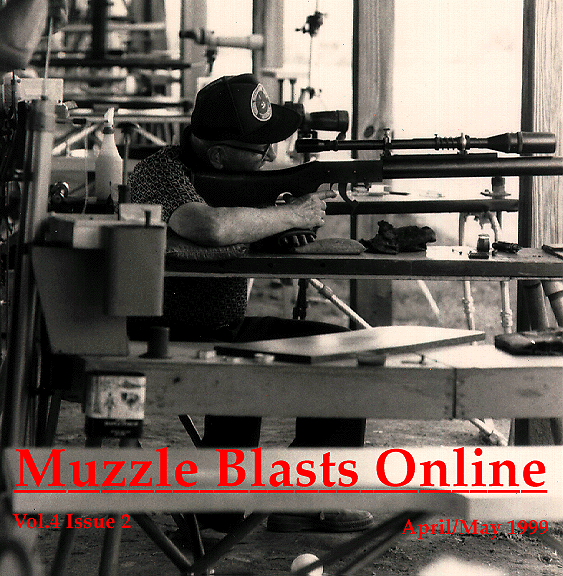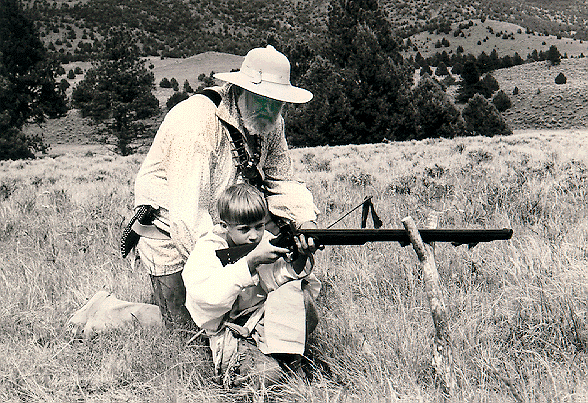|
Muzzle Blasts Online |
|
...for the muzzleloading enthusiast |
|
The muzzleblasts.com domain, subdomains, content, etc., are neither affiliated with the NMLRA nor its paper magazine Muzzle Blasts |
|
Muzzle Blasts Online |

|
|
|
|
|
|
The Importance of Rifle Length

|
|
Dale Nelson coaches his grandson Danny while the boy shoots a 20-gauge Trade Gun from cross-sticks |
Mr. John Woolfolk, a good friend and pen pal whom I've never met, mentioned a good idea in a letter about informing parents concerning the troubles young kids have with rifle length. He talked about how he has seen little kids in the pee-wee match having trouble reaching the triggers, and sometimes the kid gets a poor score because of this problem. Mr. Woolfolk thinks that kids could shoot much better if they only had a smaller, better fitting rifle to use. I realized that his idea is very true and a problem that parents might overlook. Here are a few helpful hints and ideas that might make shooting more comfortable for both youngsters and their parents.
Parents do feel proud when their kids learn how to shoot well. What makes them even more proud is when the kids enjoy shooting their own guns. Sometimes, a kid might be too anxious to shoot the rifle and won't tell their parents if it is too uncomfortable. A parent might rush the child into shooting too quickly and not be able to see the subtle problems.
To give kids the most help, start them out using a rifle with an appropriate length of pull. (Length of pull is the distance from the center of the buttplate to the trigger.) The rifle could either be a short .22 caliber rimfire, or a small muzzleloader, or even an air rifle (BB gun). All of these types of rifles are very good for training a beginner. Parents also need to be careful about observing all the rules of shooting safety.
It is best to use very small loads in a muzzleloader, so the kid won't jump from recoil and the muzzle blast. Have kids wear ear protection at all times. (Set a good example and wear ear protection yourself.) Eye protection is also essential. For starters, by all means have the kids shoot from a bench or from a prone position (e.g., over a log) so they don't have to support the weight of the rifle.
In order to make sure that your students can control the rifle and aim it safely by themselves, have your kids "tested" by aiming, with the rifle unloaded, at a target. This is a good time to train the kids with "dry fire" by snapping the set triggers, if the rifle has them, or snapping the lock on something that will allow it (such as a nipple protector or a wooden substitute for a flint). If your young students can't hold up the rifle, have them shoot from a support such as cross sticks.
Before you really start shooting with a youngster (or any beginner), coach him or her on how to hold and handle the rifle safely, and how to aim properly with the sights. When Dad was teaching me how to shoot rifles (he still is my best coach), he had me read excerpts from books about rifles. Afterwards, he quizzed me by getting me a rifle, and I had to identify the important parts such as sights, safeties, hammers, triggers, the muzzle, and any other important parts of the rifle. The point is to get your student familiar with the rifle and its parts. Dad explained to me several years ago, "If I must tell you to take your finger off the trigger, you've got to know what I'm talking about."
During those times when Dad quizzed me, when I was doing my first shooting, we also shot various rifles that he had that were small enough for me to use. At that time we didn't have any benches to shoot from, so to make shooting much steadier for me, Dad would hold a pair of cross sticks while I shot at the targets. While he did that, he was behind me and on my left side, where he was in a safe position without bothering my shooting (I am a right-handed shooter).
The very first rifle of Dad's I ever shot was his old Winchester Model 1906 pump .22 with a shortened stock. This rifle would also use .22 Shorts or CB Caps, which we used more often than the normal .22's because they are quieter. We shot at brown paper shopping bags with a bright red circle stuck on the broad side. The bags weren't placed too far away; the farthest distance was around 25 feet. While we were shooting together, Dad would always give me tips and advice between shots.
The first muzzleloader I ever shot was Dad's .36 caliber flintlock York County rifle with a 40" barrel, called 'Black Rabbit.' The stock was really too long for me (nearly a 14" length of pull) but Dad had the rifle rested over a stack of firewood so I could hold the rifle with no problem. The first shots I took from that rifle were while using only 5 grains of powder behind the .36 caliber patched ball at a paper bag target only a few yards away. That target was close enough that I could see my hits, and they were good hits too. There is no point in starting a learning shooter with a target so far away they can't hit it. My first muzzleloader shooting was a very good experience.
During that time, we were measuring me for my best length of pull for a rifle. Dad would do this by handing me one of his rifles and having me aim it. Then he would ask "How does that feel?" I would answer him by saying "It's too long," or "I can't reach the trigger." That way Dad would have a good idea about what rifles I could use and which rifles I should avoid, allowing me to pick the rifle that was most comfortable for me, where I could easily reach the triggers.

|
|
Dixie's Deluxe Cub .40 rifle (flintlock or percussion) is a fine, light, short-barreled rifle made especially for ladies or youngsters. |
What I didn't know at the time was that Dad was seeing if I was ready for a rifle that was already on its way from Dixie Gun Works. That was the Dixie Cub, a .40 caliber rifle with a 28" barrel. While the barrel is rather short, making the Cub a light and easy-to-handle rifle, the length of pull is 13 1/2". Now that length of pull is just fine and my custom TVM Tennessee Rifle has the same length stock. When I got the Dixie Cub, however, I was only nine years old, and the little Cub was actually a little too long for me.
Barrel length really doesn't make a lot of difference to shooters in the pee-wee class. They shoot with rests or cross-sticks and don't have to support the entire rifle. For kids in the junior class it is different story, and juniors should have rather short-barreled rifles for off-hand shooting. My comments are generalizations, certainly, but at shoots and rendezvous I've seen several kids shooting rifles that are too big for them.
The best thing to do is to get rifles that fit. Jack Garner, the boss at Tennessee Valley Manufacturing, gets custom orders for rifles with lengths of pull shorter than thirteen inches quite often, and I know of one Tennessee Rifle he's making with a 12 1/2" pull right now. Short rifles don't have to be custom built; several companies have little rifles for our youngest shooters. Getting a rifle that fits the shooter is one of the greatest gun buying investments you can make, because the shooter will enjoy shooting more, and shoot better too. Getting a gun that fits is really the only way to go.